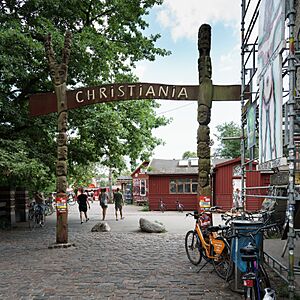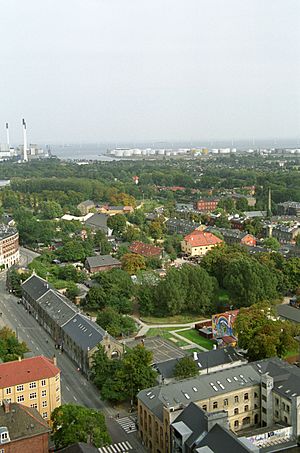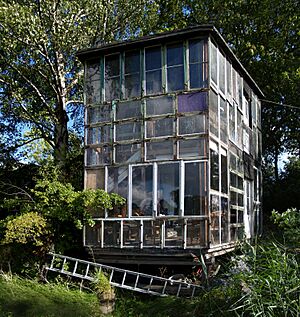Freetown Christiania facts for kids
Freetown Christiania (Danish: Fristaden Christiania), also called Christiania, is a special place in Copenhagen, the capital city of Denmark. It is a self-governing community located in the Christianshavn area. Christiania started in 1971 when people began living in an old military base.
Exploring Christiania's Culture
Christiania is a very popular spot for visitors in Copenhagen. About half a million people visit it every year. This makes it one of the city's top tourist attractions.
The people who live in Christiania are called Christianit. They are also sometimes called Christianshavner or Amagerkaner. This is because Christiania is on the island of Amager. A protest song from 1976, "I kan ikke slå os ihjel" ("You cannot kill us"), became Christiania's unofficial song. It was written by Tom Lunden from the rock band Bifrost.
Understanding Christiania's Geography
Christiania is a unique community with about 850 to 1,000 residents. It covers an area of 7.7 hectares (about 19 acres). This special area is part of the Christianshavn borough in Copenhagen, which is on the island of Amager.
The land where Christiania is located used to be a military base called Bådsmandsstræde. It also includes parts of old city walls, known as ramparts. These ramparts and the Christianshavn area were created in 1617. King Christian IV built them by adding land to the coast between Copenhagen and Amager.
After a big battle in 1658, the ramparts were made even stronger. This happened between 1682 and 1692 under King Christian V. The goal was to create a full circle of defense around the city. While most of Copenhagen's old walls were taken down in the 1800s, the Christianshavn ramparts stayed. Today, they are seen as some of the best-preserved defense structures from the 1600s in the world.
The outermost defense line is called Enveloppen. In Christiania, it is now known as Dyssen. You can reach it by a bridge over the main moat. There are four old buildings that used to store gunpowder along these walls. They were built in 1779–1780. This was after an explosion in central Copenhagen in 1770 killed 50 people. These buildings now have new names like Aircondition, Autogena, Fakirskolen ('the Fakir School'), and Kosmiske Blomst ('Cosmic Flower'). Even though they are protected, they have been changed a little from their original look.
In 2007, a government agency suggested protecting some of these old military buildings. These buildings are now part of Christiania. After many discussions, the people of Christiania agreed to buy the land. This happened in June 2011. They made their first payment in July 2012. This made them the official legal owners of their community.
See also
 In Spanish: Ciudad Libre de Christiania para niños
In Spanish: Ciudad Libre de Christiania para niños




